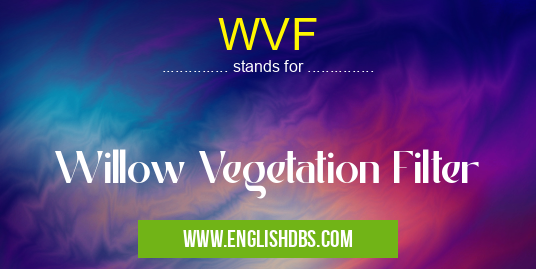What does WVF mean in UNCLASSIFIED
A WVF is a planted bed of willow trees or shrubs designed to treat and remove pollutants from runoff water. It combines the benefits of physical filtration, biological uptake, and evapotranspiration.

WVF meaning in Unclassified in Miscellaneous
WVF mostly used in an acronym Unclassified in Category Miscellaneous that means Willow Vegetation Filter
Shorthand: WVF,
Full Form: Willow Vegetation Filter
For more information of "Willow Vegetation Filter", see the section below.
- WVF stands for Willow Vegetation Filter.
- It is a type of natural water treatment system that utilizes the natural ability of willow trees to remove pollutants from water.
- Willow trees have extensive root systems that can absorb nutrients and other contaminants from the water.
Benefits of WVF
- Effective pollutant removal: WVF can remove up to 90% of pollutants, including nitrogen, phosphorus, heavy metals, and pesticides.
- Low maintenance: Once established, WVF systems require minimal maintenance, such as occasional pruning and harvesting of willow trees.
- Habitat enhancement: Willow trees provide shade, shelter, and food sources for wildlife, enhancing the biodiversity of the area.
- Cost-effective: WVF systems are relatively inexpensive to install and operate compared to traditional water treatment technologies.
Applications
- Stormwater management: WVF can be used to treat stormwater runoff from roads, parking lots, and other impervious surfaces.
- Agricultural wastewater treatment: WVF can remove pollutants from agricultural runoff, such as fertilizer and manure.
- Septic system effluent treatment: WVF can be used to treat effluent from septic systems, reducing the environmental impact on groundwater and surface water.
Essential Questions and Answers on Willow Vegetation Filter in "MISCELLANEOUS»UNFILED"
What is a Willow Vegetation Filter (WVF)?
How does a WVF work?
The dense root system of willows slows down and filters runoff, allowing suspended particles to settle out. The plants absorb pollutants and nutrients through their roots, while evapotranspiration helps to reduce surface water flow.
What types of pollutants can a WVF remove?
WVFs are effective in removing a wide range of pollutants, including:
- Sediment and other particulate matter
- Nutrients (nitrogen, phosphorus)
- Heavy metals
- Pathogens (bacteria, viruses)
- Pharmaceuticals and personal care products
Where are WVFs commonly used?
WVFs are often used in areas with:
- Agricultural runoff
- Urban stormwater runoff
- Industrial wastewater
- Mining sites
- Septic tank effluent
What are the benefits of using a WVF?
Benefits of WVFs include:
- Cost-effective and sustainable treatment option
- Reduction of pollutants in waterways
- Creation of wildlife habitat
- Aesthetic enhancement
What are the limitations of a WVF?
Limitations of WVFs include:
- May require a large area of land
- Can be less effective during periods of high runoff
- May require maintenance, such as tree trimming and sediment removal
How should a WVF be maintained?
Proper maintenance of a WVF includes:
- Regular tree trimming to remove dead or diseased branches
- Removal of accumulated sediment to prevent clogging
- Mulching around the trees to retain moisture and suppress weeds
Final Words:
- WVF is an effective and sustainable water treatment solution that offers numerous benefits.
- It utilizes the natural abilities of willow trees to remove pollutants from water, making it an environmentally friendly and cost-effective option for various applications.
